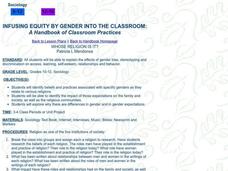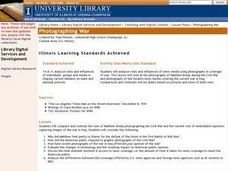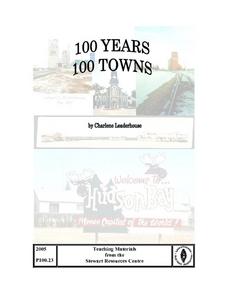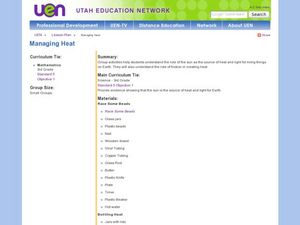Curated OER
Parts of a Book
Second graders learn to identify the parts of a book. In this book parts instructional activity, 2nd graders learn the names of book parts by participating in a teacher led instructional activity in which they look at transparencies....
Curated OER
Word Picture - Communicating Visually
Students examine how words and visual images are used to influence people. They choose a word to illustrate using both lettering and visual images. They present their work and it is critiqued by a peer review.
Curated OER
Liquids and Solids
Students describe the properties of solids and liquids, and explain how a semiconductor works. In this atom lesson students demonstrate the bonding properties of carbon and silicon.
Curated OER
President's Place
Third graders read and research the features of the White House.For this President's Place lesson, 3rd graders read an article determine the main idea. Students understand how to footnote an article.
Curated OER
Newbery Books: Guaranteed Good Reading
Sixth graders explore and analyze Newbery Medal books. They view a Powerpoint presentation on the Newbery Medal book of that current year, select a book, read and analyze the book, and prepare a multimedia book report presentation.
Curated OER
Elders as Resources
Students participate in an oral history project where they interview a person's valuable insights to their life stories. They gain personal experience in an interactive process that brings history alive all over again. Students conduct...
Curated OER
So You Want to Be a TV Reporter!
Pupils work in pairs to interview each other. They identify interviewing skills and methods, conduct a preliminary interview, develop a working script from the notes and participate in a final interview for the camera.
Curated OER
Revolutions Lecture/Discussion
Ninth graders read and discuss Chapter nine from the novel "Animal Farm" and follow up with discussions of the Russian, French, and Chinese revolutions, focusing on the causes and reprecussions of each.
Curated OER
Strategic Skill: Evaluating Information Quality Using Electronic Sources
Fourth graders review and complete evaluating information quality. In groups, they research the diversity of the numerous Native American tribes in Montana. They complete a worksheet on evaluating sources on the Internet and share...
Curated OER
Information Problem Solving--Lesson 3 of 5
Students examine a selected story/book and practice identifying the setting, characterization, and plot. As a class, they identify problems in the story, turning points and the climax. They use a rubric to evaluate the story, as well.
Curated OER
Move It!
Students explore the notion that simple devices can help us move objects when an understanding of forces is applied. They apply the design process, make predictions, draw sketches, make a model and evaluate their solution.
Curated OER
The Importance of Plants to Native Cultures in the Past and Present
Eighth graders investigate the founding and history of Sluice Boxes State Park. They use both primary and secondary resources to collect data. The focus is upon the use of native plants to make medicines. They write reports about several...
Curated OER
Who's Who and How Do You Know for Sure?
Students investigate the applications of DNA fingerprinting, They read crime scenarios and using the details of the crime and laboratory experimentation decide the suspects guilt or innocence.
Curated OER
Quality of Information: Point of View and Bias
Fifth graders identify stereotypes of Indian people based on perceived characteristics. They discuss the misconceptions. Students define quality of information and give an example from the story "Seaman's Journal: On The Trail With Lewis...
Curated OER
Paul Revere's Ride and the American Revolution
Students analyze the cause, results, and critical historic figures and events of the American Revolution. In this American Revolution lesson, students review Paul Revere's significance and the Battles of Lexington and Concord. Students...
Curated OER
Ecosystems
Sixth graders perform various labs, create presentations, and do hands on activities to explore the ecosystem.
Curated OER
Photographing War
Students examine the role of Matthew Brady photographing the Civil War and compare it with the role of photographers embedded in the War in Iraq.
Curated OER
100 Years 100 Towns
Students study Saskatchewan's Centennial by researching the history. They determine how the town celebrates the Centennial and write a report about it based on the given rubric..
Curated OER
We Are People of the Cross
Seventh graders explore the cross as a symbol of redemption and of the Trinity. They become aware of Jesus' crucifixion and the history of the crucifix.
Curated OER
Introduction of Primary Sources
First graders examine a database to explain the use of primary source documents.
Curated OER
Managing Heat
Third graders perform various experiments to show the flow of energy that causes heat. For this heat lesson, 3rd graders understand how heat is transferred or trapped. Students use the scientific method and critical thinking skills to...
Curated OER
Battery Power
Sixth graders examine how much energy they use in the form of battery power. They examine the cost of using regular vs. rechargeable batteries and examine the effect on the environment of the two types of batteries. They discover that...
Curated OER
What Is the Attraction of the 1950s?
Fifth graders, using HyperStudio or PowerPoint, select the ten most important events that happened in the 1950s.
Other popular searches
- Library Media Center
- Library Media Skills
- School Library Media Center
- Library Media Specialist
- Library Media & Atlas
- Library Media Class
- Library Media and Technology
- Library Media Lessons
- Library Media Lesson Plans
- School Library Media Plans
- Library/media Lessons
- Library Media Center Plans

























